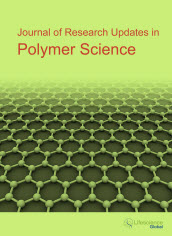jrups
Abstract : Structure of Crystallizable Polymer Solutions
|
|
Abstract: Visually transparent solutions of crystallizable polymers in wide concentration and temperature ranges contain supramolecular particles which are fragments of the most perfect crystallites of condensed polymer. Though the fraction of these particles is usually with in 0.001-0.1wt % of the total polymer, their presence in a solution of macromolecules severely affects its physicochemical and technological properties (performance) and complicates (or even does not allow) the application of structurally-sensitive research techniques (e.g. lights cattering, dynamic birefringence, etc.). The parameters of the first-level supramolecular particles (just after visual dissolution) depend on the conditions of dissolution, storage, and the preliminary treatment temperature of the polymer. In wide polymer concentration and temperature ranges, a second level of the supramolecular particles ensemble is formed, with characteristic features of crystallization. From the formation rate of the second-level supramolecular particles, a microliquidus curve for them can be plotted. The paper presents data for the poly (vinyl alcohol) + water system which lack the area of liquid-liquid phase separation. Supramolecular particles parameters (average sizes, numerical and mass-volume concentration) were determined by means of the turbidity spectrum method. Keywords: Crystallizable polymer, supramolecular particles, crystallites, light scattering, turbidity spectrum method.Download Full Article |
Abstract : Characterization of Phosphate Glass Reinforced Gelatin Blend Bioactive Composite Films
|
|
Abstract: Bioactive composite films were prepared using bioresorbable phosphate glass powder and biodegradable polymer gelatin (G) through solution casting process. Biocompatible monomer, 2-hydroxyethyl methacrylate (HEMA) was used as the cross-linking agent and bioresorbable phosphate glass (PG) powder was used as reinforcement filler. The composite films were obtained at various ratios of G, PG and HEMA. The PG modified gelatin composite (PG/G) film was fabricated at a weight ratio of 12:88 while HEMA modified gelatin composite (HEMA/G) film at 50:50 ratio. On the other hand, hybrid gelatin composite film, containing both PG and HEMA, was obtained using a G/PG/HEMA ratio of 44:12:44. Incorporation of PG improved the mechanical properties of the composite films. Morphological property of the composite films was investigated by stereo microscope and it revealed that the composite films were porous in nature. The thermal behaviour of the films was studied using thermogravimetric analysis. Water uptake of the films was also performed. Keywords: Gelatin, phosphate glass, bioactive, composite films, stereo microscope.Download Full Article |
Abstract : Copper Ion Doped Mullite Composite in Poly (vinylidene Fluoride) Matrix: Effect on Microstructure, Phase Behavior and Electrical Properties
|
|
Abstract: Highly crystallized copper ion doped mullite composites have been synthesized at 1100°C and 1400°C via sol-gel technique with five different strengths of copper ion and was incorporated in poly-vinylidene fluoride (PVDF) to make doped mullite composite/polymer films. We have studied the effects of this dopant on microstructure, phase transformation, and electrical properties of the polymer films over a wide range of frequency from 1.0 KHz to 2.0 MHz. Characterizations were done by various analytical tools at room temperature. Prominent mullite phases were observed from XRD, FTIR spectroscopy and FESEM characterization of composite polymer. The concentration of the dopant and the sintering temperature were found to be the two basic factors which affect the phase transition of the polymer. The composite film showed maximum dielectric constant of 19.96 at 1 KHz for 1.2M concentration of copper ion doped mullite sintered at 1400°C, compared to 3.09 for the pure polymer. Furthermore, both dielectric constant and electrical conductivity of the composite were found to be highly frequency and temperature dependent. After doping, the A.C. conductivity of the composite was found to increase with increasing temperature following Jonscher’s power law and the electrical resistivity reduced too. Moreover, the results revealed that the phase behaviors and micro structural changes of the copper ion doped mullite composite/polymer film affected its electrical properties with possible impact on its applications. Keywords: Polymer, Mullite, Sol–gel technique, XRD, FTIR, Dielectric properties, FESEM.Download Full Article |
Abstract : Mechanical Recycling of PET Waste from Non-Woven Fabrics by Reactive Extrusion with Chain Extenders
|
|
Abstract: Mechanical recycling of poly (ethylene terephthalate) (PET) is an important industrial activity with direct effect for environmental saving. However, recycled PET (R-PET) undergoes progressive degradation during each recycling process, leading to considerable loss of properties such as mechanical, thermal and melting strength. Chain extenders have been successfully used to increase molecular weight of R-PET, improving process ability and mechanical performance of the material. The aims of this work was to evaluate the performance of the compounds polymeric methylene diphenyldiisocyanate (PMDI) and bis-(2,4-di-t-butylphenol) pentaerythritoldiphosphite (Irgafos®126) for potential use as chain extenders when compared to the traditional chain extender pyromelliticdianhydride (PMDA). Tensile testing, differential exploratory calorimetry, viscometry and dynamic rheometry were used to evaluate changes in mechanical properties, crystallinity, molecular weight and rheological properties of R-PET. PMDI showed effective action on increase in molecular weight and improvements in mechanical and rheological properties of R-PET, while Irgafos 126 causes depreciation of properties of the R-PET after initially to increase the molecular weight of the polymer. Thus, the use of PDMI as chain extension can represent an important alternative for mechanical recycling of highly degraded PET. Keywords: PET, recycling, diisocyanate, phosphite, PMDA, chain extender.Download Full Article |






















